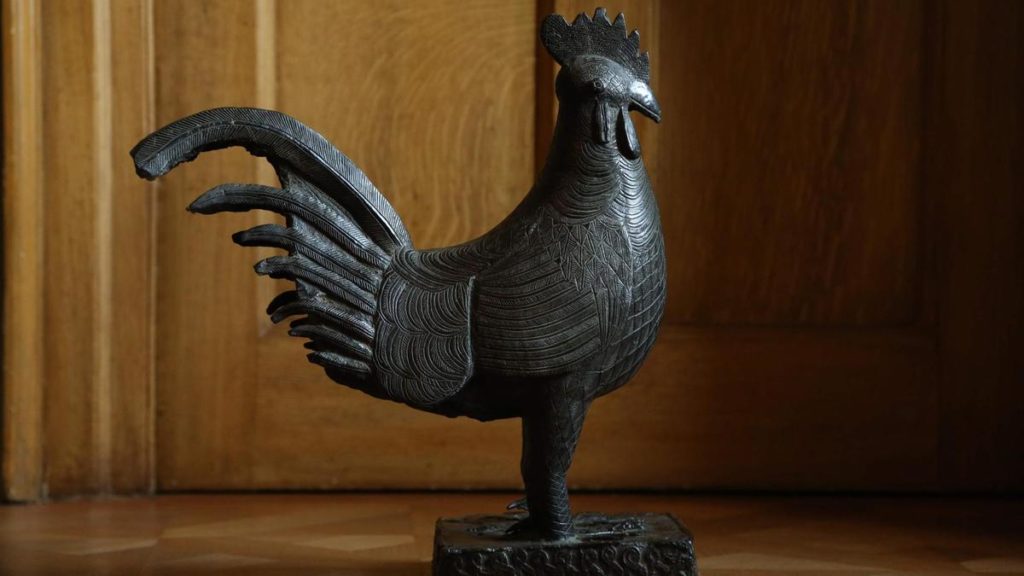Let’s face it, the treatment of colonial-era art can’t really ever be a science. Certainly not in the 21st century, with its increasingly acrimonious debate over race, sovereignty and historic injustice. Even so, politicians, academics and activists, both east and west, say that it’s a start to at least acknowledge the reasons African and Asian artefacts are on display in European museums and public institutions and then to return them respectfully.
Last week, a college in the University of Cambridge, England, did just that. Jesus College announced that it will send back Okukor, the statue of a cockerel taken in 1897 by a British expedition from Benin City in what is now southern Nigeria. Okukor had been gifted to the college by George William Neville, a former British army officer who had taken part in the bloody Benin campaign and whose son had studied at Jesus college. It had been on display in the college dining hall for 86 years until a student protest in 2016.
What is interesting about the current state of the worldwide debate is the no-go areas. Big-ticket items, such as the Elgin Marbles from ancient Greece and the Kohinoor diamond from the Indian subcontinent remain firmly off the agenda
Okukor’s planned return home comes at an interesting moment in the charged and testy debate over who gets to display what and why. The week before the announcement from Jesus College, Manchester Museum handed over to indigenous leaders 12 aboriginal artefacts taken from Australia more than 100 years ago. Just days before that, in Dakar, French prime minister Edouard Philippe restored to Senegal’s president Macky Sall a sabre that had belonged to Hadj Omar Tall, a 19th-century military commander who led an anti-colonial struggle against the French.
Three repatriations in one month of artefacts appropriated by colonialists has to be significant. Add to that three further developments in recent months.
First is the fact that the Humboldt Forum — one of Europe’s most ambitious and expensive displays of world cultures in the centre of Berlin — has had to push back its opening from this year to next because of a storm of difficult questions about the treatment of colonial-era art. French historian Benedicte Savoy had already resigned from the Humboldt’s advisory council, saying “how much blood [was] dripping” from the ethnographic artefacts. Second, France has said it will help fund the construction of a museum in Nigeria to house repatriated artefacts that include statutes and thrones looted by French troops in the 19th century. And last but not least, there is the $15 million, four-year initiative launched last month by the Open Society Foundations — a US-headquartered philanthropic organisation — to support African lawyers, scholars and grassroots organisations campaigning for the return of artefacts.
Clearly, a remarkable reckoning of sorts is under way.
In October 2018, I had written about efforts to more fairly appraise and showcase history some 70 years after the sweeping changes brought about by decolonisation. Back then it did not seem possible that European capitals would be prepared to return masks, thrones, statues and jewellery appropriated from parts of Africa and Asian capitals. It seemed doubtful that they would acknowledge the damage done to many cultures by the pillaging of ritually and symbolically items.
But then came a report commissioned by French president Emmanuel Macron from Ms Savoy, formerly of the Humboldt Forum, and Senegalese writer Felwine Sarr. The report said that more than 90 per cent of the “material cultural legacy” of sub-Saharan Africa was outside the continent and that Europeans were straining to justify their continued possession of such treasure, while “Africans find themselves struggling to recover the thread of an interrupted memory”.

That report may prove to be a gamechanger. It recommended that objects seized by France during the colonial era be returned to their countries of origin if a country asks for them. The new and emollient French approach clearly makes it harder for other former European colonial powers — Britain, Belgium, the Netherlands, Germany, Portugal and Italy — to hang back from restitution. A year ago, even the US, which has not generally been plagued by such issues not having been a leader in the colonial era, returned the iconic church bells looted as war trophies from Balangiga town in the Philippines during the 1899–1902 war.
Even so, what is interesting about the current state of the worldwide debate is the no-go areas. Big-ticket items, such as the Elgin Marbles from ancient Greece and the Kohinoor diamond from the Indian subcontinent remain firmly off the agenda. The Kohinoor is one of the world’s largest diamonds and has been part of the British crown jewels from the mid-19th century. It is claimed by many countries, including India, Pakistan and Afghanistan. The fifth-century BC marble sculptures from Parthenon in Greece were removed by Lord Elgin around 1800. Now in the British Museum, they provoke anguished questions about why they should be in London rather than in Athens.
Another key issue that remains largely unaddressed is the future of restituted items. How will the receiving capitals deal with their returned treasures? Also, is it even any business of London, Paris, Brussels, Berlin and others to ask this question?
Perhaps the best answer might be found in Indian economist Amartya Sen’s 2009 book The Idea of Justice, which features three children and one flute. Anne says the flute should be hers because she is the only one who knows how to play it; Bob says it should be his as he has no other toys and Carla says the flute is hers because it is the fruit of her people’s labour.
Who gets the flute depends on the philosophy of justice. Should it be legal, social or distributive? Professor Sen wrote that most people are sensible enough to know that a “perfectly just” world is a utopian dream but they want “the elimination of some outrageously unjust arrangement”.
For that flute, read Benin Bronzes, disparate masks, diamonds, thrones, and other artworks. We are nowhere near the end of this discussion.


